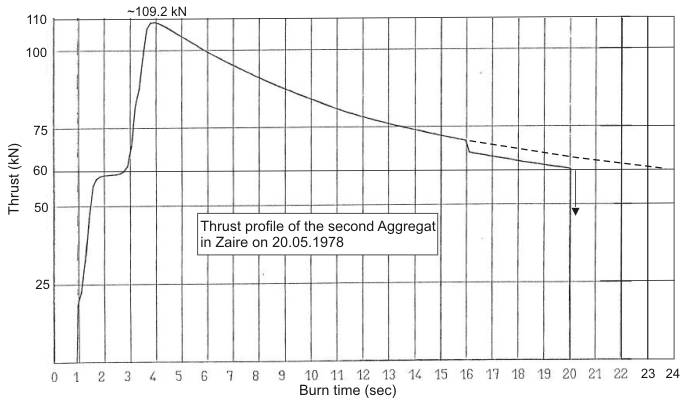|
Calculation of the
terminal
velocity (dV) of the KAYSER-I rocket
[dV = Isp [Ns/kg] * ln (Mf/Me)]
1. -- Mf - first stage: Total mass of
the launcher
Me - first stage: Empty mass of the first
stage + total mass of the second and third stage and payload
2. -- Mf - second stage: Total mass of the second and third stage
and payload
Me - second stage: Empty mass of the
second stage + third stage and payload
3. -- Mf - third stage: Total mass of the third stage and payload
Me - third stage: Empty mass of the third
stage + payload
| Conditions:
Prediced data (realistic Isp; thickness of the tanks 1.0 mm; structural
mass 17.2 % = one modul 278 kg) |
| |
vac Isp (sec) |
=Ns/kg |
Mf (kg) |
Me (kg) |
Mf/Me |
ln Mf/Me |
Isp * ln (Mf/Me) |
|
1. (48 CPMs) |
~252.5 |
2476 |
104,683 |
40,267 |
2.600 |
0.95551
|
2,366
|
| |
|
|
|
|
|
|
|
|
2. (12 CPMs) |
~252.5 |
2476 |
26,921
|
10,817
|
2.489
|
0.91188
|
2,258
|
| |
|
|
|
|
|
|
|
|
3. ( 4 CPMs) |
~252.5 |
2476 |
7,480
|
2,112
|
3,542
|
1.26469
|
3,131
|
| |
|
|
|
|
|
dV Total*
|
7,755 [m/sec]
|
* dV
without losses between 15% and 20% of velocity by gravity, air resistance
etc.
Therefore is the real dV nearby 6,400 m/sec for payload 1,000
kg.
| Conditions:
Optimistic OTRAG data (high Isp; thickness of the tanks 0.5 mm; structural
mass 12.2 % = one modul 186 kg) |
| |
vac Isp (sec) |
=Ns/kg |
Mf (kg) |
Me (kg) |
Mf/Me |
ln Mf/Me |
Isp * ln (Mf/Me) |
|
1. (48 CPMs) |
297 |
2912 |
98,792 |
34,376 |
2.874 |
1.05570
|
3,074
|
| |
|
|
|
|
|
|
|
|
2. (12 CPMs) |
297 |
2912 |
25,448
|
9,344
|
2.723
|
1.00173
|
2,917
|
| |
|
|
|
|
|
|
|
|
3. ( 4 CPMs) |
297 |
2912 |
7,112
|
1,744
|
4,078
|
1.40560
|
4,093
|
| |
|
|
|
|
|
dV Total*
|
10,084 [m/sec]
|
* dV
without losses between 15% and 20% of velocity by gravity, air resistance
etc.
Therefore is the real dV nearby 8,320 m/sec for payload 1,000
kg.
|

Source: Sven Grahn, Sweden
|
|
